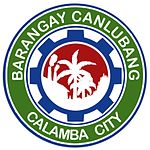Canlubang
| Canlubang | ||
|---|---|---|
| Barangay | ||

A viewed over Canlubang in Carmelray Industrial Park 1
|
||
|
||
| Coordinates: 14°11′31″N 121°4′16″E / 14.19194°N 121.07111°ECoordinates: 14°11′31″N 121°4′16″E / 14.19194°N 121.07111°E | ||
| Country | Philippines | |
| Province | Laguna | |
| Region | CALABARZON (Region IV-A) | |
| City | Calamba | |
| Center | Bo. Canlubang | |
| Government | ||
| • Chairman | Larry O. Dimayuga | |
| Area | ||
| • Land | 39.12 km2 (15.10 sq mi) | |
| Population (2014) | ||
| • Total | 63,571 | |
| ZIP code | 4028 | |
Canlubang is a major industrial zone located in the province of Laguna, southwest of Metro Manila in the Philippines. It was once a hacienda during the Spanish colonial period. Canlubang straddles two component cities of Laguna: Cabuyao, Calamba and the municipality of Silang in Cavite.
The official political unit with the name Canlubang is a barangay in Calamba City, Laguna. It is the largest and most populated barangay in Calamba.
Canlubang covers major industrial zones. It extends as far as Cabuyao and Santa Rosa, Laguna where the Nuvali Evoliving development of Ayala Land is located.
The history of Canlubang can be traced back to the 16th century. It was originally owned by a group of sangleys residing in Calamba. It was confiscated by the government and sold at a public auction to a peninsular Spaniard, Don Tomas de Andaya in 1678. It was then acquired by the Jesuits in 1759. When the Jesuits were expelled in the Philippines, the land was again confiscated by the government and sold again at a public auction to Don Jose Clemente de Azanza in 1802. It was acquired by the Dominicans in 1831.
When the Americans colonized the country, the land was classified as friar land and was again acquired by the government in 1905. Alfred Ehrman, leader of a group of American businessmen from California organized and incorporated the Calamba Sugar Estate in 1912 which purchased the friar land. The Calamba Sugar Estate managed by Louis Weinzheimer and his family is known as the second sugar central in the Philippines. The sugar mill started its operations on December 1, 1914. It also planted coconuts on its property and was a model sugar plantation from 1920 to 1930s.
...
Wikipedia

